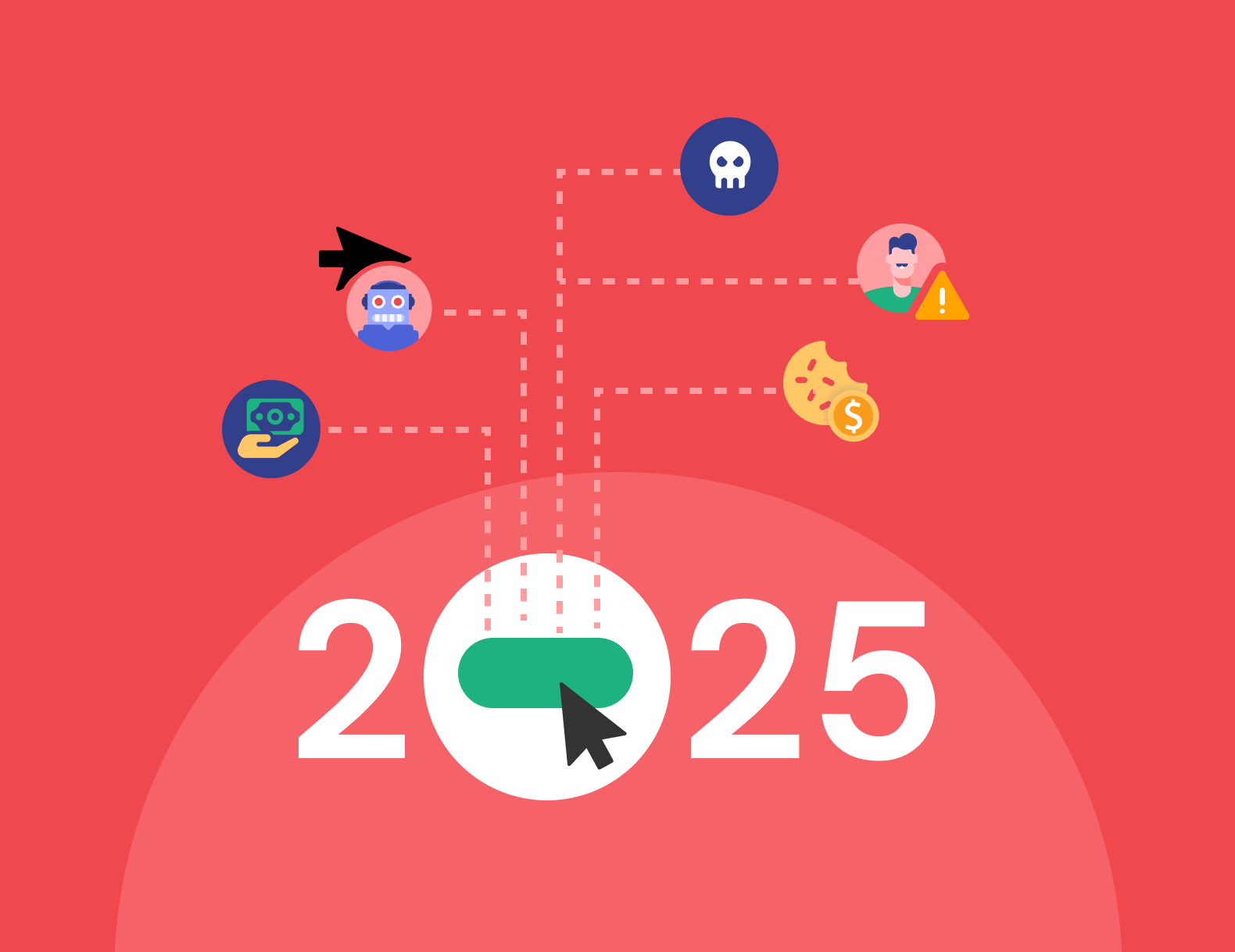Why Meta’s Own Fraud Filters Can Miss the Mark and How to Protect Ad ROI

Meta’s ad ecosystem is unrivalled in scale. With more than 3.2 billion daily active users across Facebook, Instagram, and Messenger, it’s a cornerstone of digital acquisition strategies for eCommerce brands and performance marketers. But with that scale comes risk.
Meta’s own fraud filters are designed to protect advertisers, yet sophisticated bots, click farms, and fake engagement consistently slip through the cracks. The result? Wasted spend, distorted optimisation signals, and unreliable performance data.
With global ad fraud losses projected to exceed US$172 billion, no marketer can afford to rely solely on platform filters. This blog explores why Meta’s systems fall short, the cost of undetected fraud and how independent click fraud prevention is becoming essential to protect ROI.
The Limits of In-Platform Protection
What Meta’s fraud filters are designed to catch
Meta uses automated AI systems to detect and remove obvious invalid activity: bot farms spamming clicks, accounts flagged as spam, or users repeatedly violating policy. These detections target clear-cut patterns and protect advertisers against the most blatant forms of abuse.
The blind spots bots and fake engagement exploit
Fraud has evolved. Modern AI-powered bots are engineered to mimic human behaviour such as mirroring session timing, mouse movement, and even interactions like comments or video views.
Incentivised “hyper-clickers” pose another blind spot. These are real users driven by apps or malware to click ads repeatedly, inflating engagement without genuine intent. From the platform’s perspective, this behaviour can look authentic enough to bypass filters.
Fraudsters also exploit tactics such as:
- Engagement farming: Fake likes and comments inflate relevance scores and mislead algorithms.
- Proxy traffic: VPNs and device spoofing disguise traffic sources.
- Click flooding: High-frequency clicks boost CTR metrics but never translate into conversions.
These are precisely the types of activity flagged in TrafficGuard’s report, Click Fraud in 2025: Trends, Threats, and How to Stay Ahead. The report shows how fraudsters are scaling attacks with AI, often leaving platform-level detection behind.
Why advertisers can’t rely on platform data alone
Meta has every incentive to prioritise engagement; after all, it earns revenue for every impression and click. That creates a conflict of interest when the same system that measures campaign performance also profits from inflated traffic.
Without independent verification, advertisers cannot separate genuine signals from invalid ones. Relying exclusively on Meta’s data leaves campaigns exposed to hidden inefficiencies and budget leakage.
The Real Cost of Missed Fraud on Meta Campaigns
How bots and hyper-clickers inflate spend
Invalid clicks drain budgets quickly, especially in verticals like retail and eCommerce where CPCs are already high. A bot that never converts has the same financial impact as a real user click except it delivers zero value.
Industry estimates suggest advertisers lose around 10–30% of paid social spend to fraud and invalid traffic. For a brand investing $50,000 a month into Meta ads, that equates to $5,000–$15,000 wasted before campaigns even optimise.
Fake engagement and its impact on optimisation signals
Click fraud does more than steal spend. It poisons campaign optimisation. Fake likes, comments, and shares distort Meta’s algorithm, which reallocates budgets to audiences and creatives that will never drive sales.
The result? Advertisers end up scaling campaigns around the wrong signals, leading to declining ROAS over time.
Why skewed reporting undermines ROI
Invalid traffic inflates performance dashboards, but sales numbers tell the real story. When metrics are corrupted, customer acquisition costs climb, bidding strategies misfire, and marketers lose the ability to trust their own data.
Without clean data, every optimisation decision is compromised.
Why CPM pricing makes bots even more costly
Meta charges on a CPM basis, meaning advertisers pay for every thousand impressions served, not just clicks. When bots interact with ads, they don’t just generate invalid clicks; they become a magnet for more impressions.
Each impression shown to a bot drives up spend without adding any real potential for conversions. Over time, these phantom interactions can quickly drain budgets, especially on campaigns optimised for reach or engagement, making every dollar less effective. In effect, a single bot can multiply wasted spend by repeatedly triggering impressions and clicks across multiple campaign
Spotting the Warning Signs Early
Abnormal click-through rates and conversion drops
If CTR rises sharply but conversions don’t follow, it’s often invalid traffic. Bots and hyper-clickers drive the clicks, but they never add value.
Unusual geographies and audience anomalies
Fraud often originates from regions outside your target parameters. Unexpected spikes in geographies you’re not bidding on can signal proxy traffic or bot interference.
Bounce rates as a red flag for invalid traffic
When users land on your page and exit instantly at scale, it’s a strong sign they weren’t real prospects to begin with. High bounce rates paired with high ad spend are a tell-tale fraud signal.
Smarter Protection Beyond Meta’s Filters
Why independent verification matters
Platform filters are not designed to catch everything. Independent click fraud prevention tools such as TrafficGuard provide a neutral lens, validating every click and impression before spend is committed.
TrafficGuard for Social integrates directly with Meta Ads Manager to track and verify traffic in real time. By filtering invalid activity beyond Meta’s detection, it ensures every penny fuels real engagement.
Clean data as the foundation for growth
With invalid traffic removed, optimisation models train on genuine signals. Campaign reporting reflects true performance, bidding becomes more efficient, and budgets scale with confidence.
How marketers can future-proof Meta ad spend
Fraud evolves, but so does prevention. With TrafficGuard’s audit and protection tools, marketers can move from reactive detection to proactive prevention, stopping fraud before it drains spend. This future-proofs Meta campaigns against the next wave of bot-driven threats.
Conclusion
Platform filters aren’t enough to safeguard ROI
Meta’s built-in fraud filters protect against basic abuse but leave blind spots that sophisticated fraud exploits.
Smarter fraud prevention is a competitive advantage
Independent verification ensures every click is genuine and every engagement counts. That’s not just protection, it’s a growth multiplier.
Clean data drives better ads, every time
The best Meta campaigns are powered by accurate, trustworthy signals. With click fraud prevention in place, advertisers can scale efficiently, protect ROI, and outpace competitors.
FAQs & Key Takeaways
- Doesn’t Meta already filter invalid traffic?
Yes, Meta applies automated fraud filters, but they focus on obvious invalid activity such as spam accounts and repeat offenders. More sophisticated bots and incentivised clickers often go undetected. That’s why many advertisers see discrepancies between platform reporting and actual sales. To understand why, see our blog on Click Fraud in 2025: Trends, Threats, and How to Stay Ahead.
- How does TrafficGuard work with Meta campaigns?
TrafficGuard for Social integrates directly with Meta Ads Manager. It verifies every click and impression in real time, filtering out invalid traffic before it affects your campaigns. This ensures your budget only fuels genuine engagement. Learn more about TrafficGuard for Social.
- What results can I expect from using TrafficGuard with Meta?
Results vary by campaign and vertical, but many advertisers see immediate budget recovery and a measurable uplift in ROAS. For example, eCommerce brands often cut wasted spend by double-digit percentages within weeks. See how brands unlock growth in our case studies. - Is click fraud protection only relevant for large Meta advertisers?
No. Whether you spend $5,000 or $500,000 a month, invalid clicks eat into ROI. TrafficGuard protects advertisers of all sizes by ensuring every ad pound counts. You can explore pricing options here. - How do I get started with TrafficGuard?
Getting started is simple. Share your Meta Ads ID, and TrafficGuard will set up your account for monitoring. Within days, you’ll see exactly how much invalid traffic is draining your budget. Begin by requesting your free audit.
Get started - it's free
You can set up a TrafficGuard account in minutes, so we’ll be protecting your campaigns before you can say ‘sky-high ROI’.
Subscribe
Subscribe now to get all the latest news and insights on digital advertising, machine learning and ad fraud.








